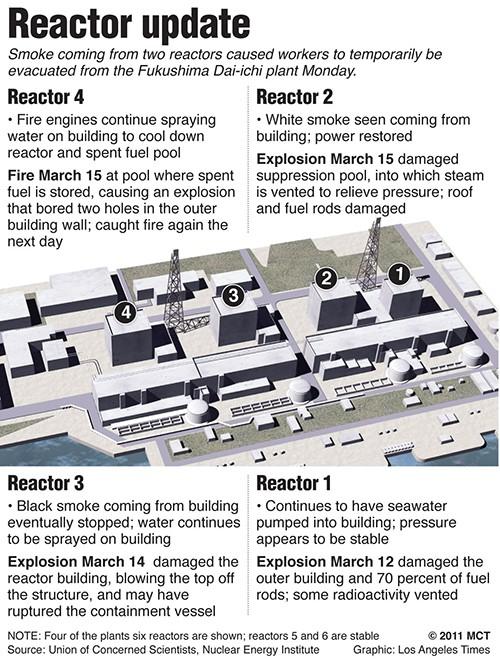TOKYO — Power cables have been reconnected to all six reactors in Japan’s quake-crippled nuclear complex, the plant’s operator said Tuesday, in what was hailed as possible turning point in the struggle to bring dangerous overheating under control and avert a large-scale release of radiation.
Tokyo Electric Power Co, or Tepco, tempered that news with warnings that various pieces of equipment must be checked before the restored electricity can be used to operate cooling systems at the plant 150 miles north of Tokyo.
Late Tuesday, Japanese officials expressed guarded optimism, saying they had successfully switched on lights at the control room of the No. 3 reactor, a sign that power had successfully been restored and equipment to monitor temperature and water levels may soon become operational. Reactor No. 3 has been a cause for particular concern because it is powered by a mixed oxide fuel containing highly carcinogenic plutonium.
Meanwhile, the death toll in the quake-and-tsunami disaster marched inexorably upward. Nearly 10,000 are confirmed dead, with more than 13,000 missing as a result of the March 11 earthquake and the devastating waves that crashed ashore soon after, Japan’s national police reported late Tuesday. Bodies are still being recovered daily, though the grim realization is setting in that many victims simply vanished without a trace.
As during much of the long struggle to cool reactors in the ruined Fukishima complex, progress and new worries combined on Tuesday evening. An official from Japan’s nuclear safety agency, Hidehiko Nishiyama, said temperatures in a spent-fuel pool at the No. 2 reactor were thought to be at around the boiling point — raising the risk of the fuel inside being exposed. However, authorities said they were cooling the pool with tons of seawater.
Earlier, Japanese Defense Minister Toshimi Kitazawa had said white smoke from the reactor could have been steam and that a darker plume from the No. 3 reactor was debris that had been set on fire by the building’s rising temperature, the Kyodo news agency reported.
By midday, firefighters and Japanese Self-Defense Forces deemed the situation safe enough to return to continue spraying the building housing the No. 3 reactor, Kyodo said.
Some Japanese scientists said the setbacks didn’t appear to signal a deteriorating situation at Fukushima, where workers had been making progress in the painstaking task of containing the nuclear crisis.
Still, the sudden black and gray plumes, and a temporary increase in radiation levels around the plant on Monday, underscored the still precarious scene at the Fukushima Daiichi nuclear facility, where the March 11 Tohoku earthquake and tsunami knocked out the plant’s outside power and emergency cooling systems, causing radiation leaks from multiple sources.
The interruption delayed by a day efforts to restore power to the cooling systems at the plant. The smoke also caused fire officials to halt the spraying of water onto the reactors.
The snag came on a day when the executive director of the U.S. Nuclear Regulatory Commission, Bill Borchardt, said that the agency’s staff in Japan reported that the three reactors probably had suffered core damage but did not appear to be leaking significant amounts of radiation.
“”I say optimistically that things appear to be on the verge of stabilizing,”” Borchardt said.
In Japan and abroad, however, concerns over radiation fallout grew. On Monday, Japanese officials said they detected higher than normal radiation levels in samples of seawater around the power complex. And residents of at least one village near the nuclear plant were ordered not to drink tap water.
Japanese authorities Monday also ordered farmers in Fukushima prefecture to halt shipments of milk. And three other nearby prefectures, along with Fukushima, were told to stop shipping spinach and some other vegetables after traces of the radioactive isotopes iodine-131 and cesium -37 were found in batches from regions surrounding the plant.
World health officials warned of potential dangers posed by the tainted food. In a sign of the potential problem for Japan’s food exports and international image, one Japanese restaurant in Taiwan was reportedly providing radiation gauges with its meals.
World Health Organization officials advised people living near the plant who may have consumed tainted produce or animal products to seek medical attention.
The governments of China, South Korea and the Philippines have ordered screening of imports from Japan for radiation contamination.
Many Japanese in the tsunami zone, meanwhile, were still experiencing acute shortages of food and gasoline, which caused long lines and shorter tempers.
Many restaurants in the northeastern portion of the country were printing abbreviated menus of five or six dishes. Convenience stores were running out of food, and at several locations lines stretched around the block with people seeking such staples as water and rice.
The lingering gasoline shortage presented a situation that many older residents said harked back to the days of deprivation after World War II.
Most gas stations around the region remained closed. Those still open drew lines that left people waiting 12 hours or more, and then only to fill a portion of their tanks.
In the city of Senmaya, about 200 miles north of Tokyo, Sumie Sato and her husband, Naohiro, both 26, slept in their subcompact overnight to receive about 5 gallons of precious gasoline.
“”We have a 2-month-old son at home, so we can’t take any chances,”” said Sumie. “”My son has been sick, so if he gets really bad we’ll need gas to take him to the hospital.””
———
(Lee reported from Tokyo and Kim from Los Angeles. Glionna reported from Senmaya, Japan. Staff writer Thomas H. Maugh II in Los Angeles contributed to this report.)
GRAPHIC: http://www.mctdirect.com/preview.php?id=201103211510MCT_____GRAPHICS_20110321_Deaths_QUAKE









